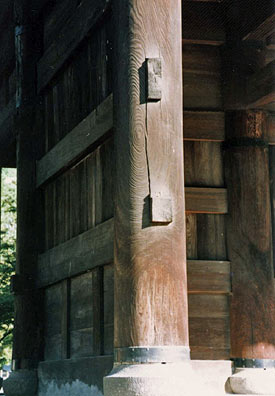|
||
 |
||
1 A circular pillar or post. In the early periods (7-13c), a log was made circular by first cutting it into a square. Next the corners were cut off to create an octagon. These eight corners were then cut off so that the pillar became sixteen sided. From this point, the wood was finally made into a circular post or pillar by skillful use of a spear-shaped plane *yariganna 槍鉋. Natural logs were round but not perfectly so. Chiseling off the irregularities of a log was sometimes used in place of the more time consuming method.

2 Circular posts used for alcoves *tokonoma 床の間, in the proto-modern periods (16-19c), which were planed to produce a smooth rounded shape. They were called mikiribashira 見切柱 or sodebashira 袖柱. Many kinds of fine wood were used for these posts: Japanese yew or hemlock, cherry, zelkova, red pine, cedar, cypress, or fir.
(C)2001 Japanese Architecture and Art Net Users System. No reproduction or republication without written permission.
掲載のテキスト・写真・イラストなど、全てのコンテンツの無断複製・転載を禁じます。

